The SoCal night Gregg Popovich's Hall of Fame career nearly died before it began
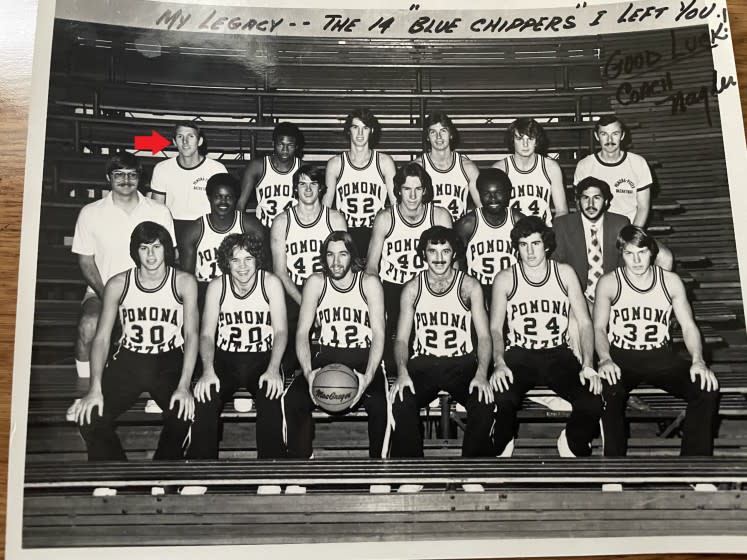
Little about the game that night in January 1980 felt worthy of posterity. No roaring crowd. No TV cameras. Nothing, really, but two woeful Division III basketball teams playing in a near-empty gym, each hoping to be just a little less bad than the other.
The home team, Pasadena-based Caltech, was fresh off a winless conference season, eight straight, in fact. The visitors, Pomona-Pitzer in the Eastern L.A. County foothills, weren’t much better. Roughly half the young men on the court hadn’t even played in high school. These were students who happened to play basketball, not the other way around.
The arc of sports bends in mysterious ways, though. Four decades later, those present at Brown Gym on Jan. 30, 1980, marvel at how it all turned out. How, with the passage of time, the events of that night gained an unexpected significance. And now they delight in telling the story — or at least some of them do — of the night a future coaching legend and a historically inept team collided, of the unexpected outcome, and all that followed.
::
Caltech point guard Peter Edwards can’t recall whether he circled the Pomona-Pitzer game on the calendar. He does know he was sick of the losing.
Edwards, a senior, was the rare Caltech player who’d not only played in high school but had been decent. As a wing at Brethren Christian in Huntington Beach, he’d provided steady defense and scrappy scoring. His future lay in academics, though. His parents had taken out a loan so he could attend Brethren.
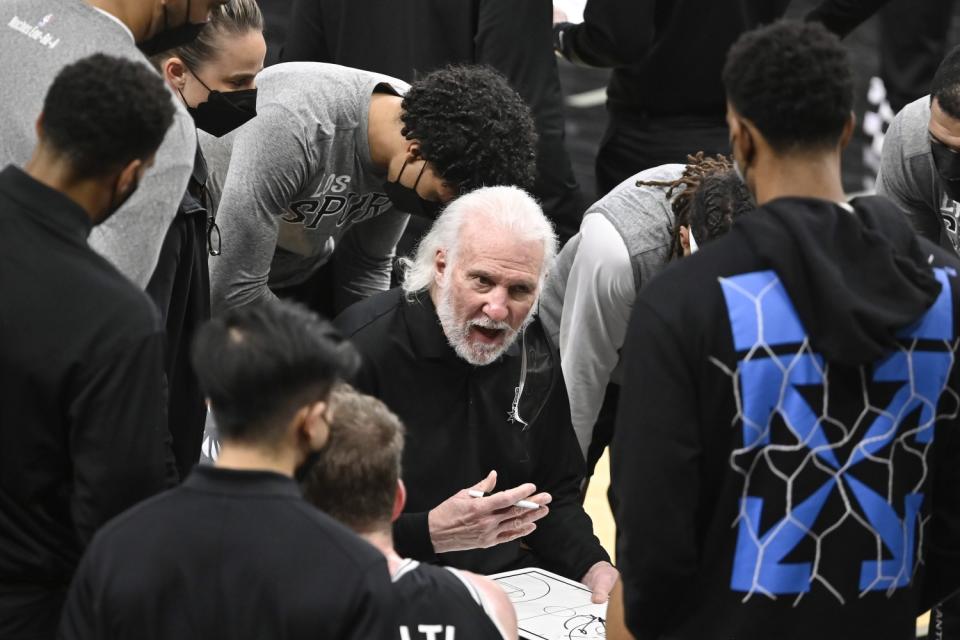
Despite a 3.98 GPA, Edwards assumed he wouldn’t get into Caltech. The home of Einstein and Richard Feynman, it churned out Nobel Prize winners the way UCLA produced NBA stars.
Which is to say that no one went to Caltech to play sports. Other than a brief heyday during the World War II era, the Beavers — so named because they are “nature’s engineers” — could reliably be found in the cellar of the Southern California Interscholastic Athletic Conference. Every 10 years or so, the campus would debate whether Caltech should even have an athletics program.
These weren’t regular losses either. Caltech lost by scores like 97-46 (Redlands), 111-44 (Occidental) and117-36 (Whittier). Some teams took pity on them; others delighted in the thrashing. “Sometimes,” Edwards says, “I’d look up in the first quarter to see a score like 25-4 and wonder, ‘Why even keep playing?’”
Now, midway through his senior season, a reality was dawning on Edwards: He might well go 0-for-college. Not only that, but Caltech boasted a conference losing streak that dated to 1971 and it now threatened triple digits. Best anyone knew, no SCIAC team, no team in any conference, anywhere, had lost 100 in a row.
Little hope appeared on the horizon. The Beavers had no chance against conference powers like Occidental. To get off the hook, everything had to break right against one of the league’s lesser lights. A team like La Verne.
Or, maybe, Pomona-Pitzer.
::
Caltech, Steve Johnson thought, now that’s a team we can beat.
For Pomona players like Johnson, a sophomore point guard, Caltech had always represented an oasis in the schedule, an opportunity to refresh and build confidence. And right now, Pomona could really use an oasis. Heading into conference season, it had but one win. And the new coach was none too happy about it.
Historically, sports, as at Caltech, had taken a back seat at Pomona. A liberal arts school of 1,400 at the foot of Mt. Baldy, east of Los Angeles, Pomona prioritized academics and culture. Coaches came from the ranks of tenure-track faculty to the point it had combined athletic departments with neighboring Pitzer College.
“The whole spirit of the program was the students should enjoy themselves,” said Steve Koblik, a politics professor at the time.
Then Robert Voelkel became Pomona’s vice president and dean of the college. A former walk-on player, Voelkel cared about sports, and basketball in particular. In the spring of 1979, determined to turn around the Sagehens program, Voelkel bypassed protocol and relieved the men’s basketball coach, a nice, mellow tenured professor named Les Nagler, of his position.
Not long after, as the story goes, he offered the job to an Air Force Academy assistant named Reggie Minton. When Minton declined, Voelkel offered it to another assistant on the same staff, an intense young man with a background in Soviet studies.
His name was Gregg Popovich.
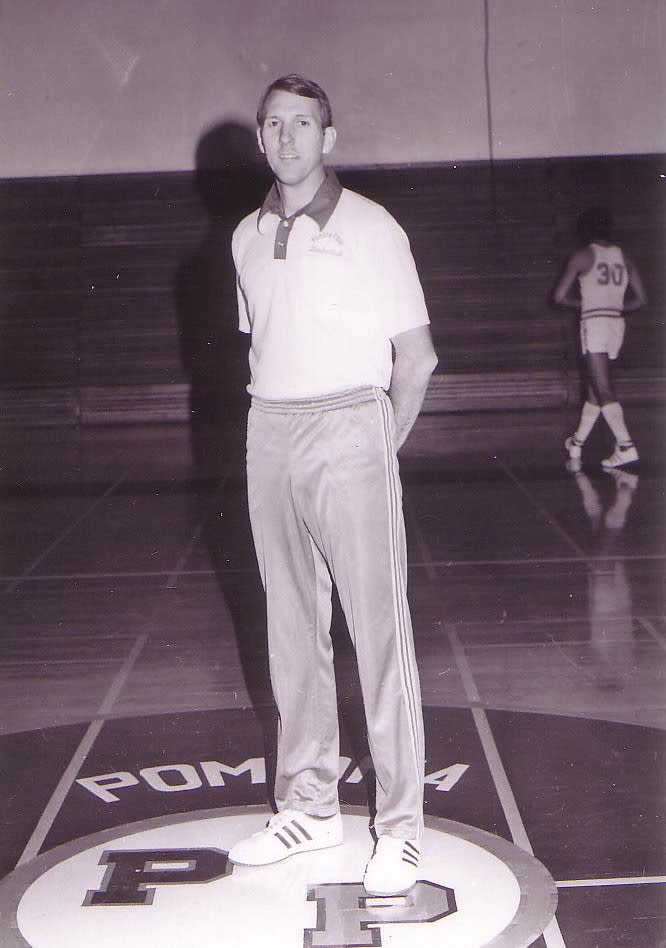
::
And so, in the fall of 1979, fliers began to appear on the Pomona campus, announcing basketball tryouts under the new coach. Johnson and a handful of others showed up.
Under Nagler, Pomona players were accustomed to a laissez-faire approach. The coach let you out of practice if a test loomed. Each week, Nagler had the team vote on the starters for games. (“Fortunately,” Johnson said, “we usually made the right decisions.”)
The new coach — skinny, hook-nosed, fond of expletives — didn’t do laissez-faire. Once practice began, Popovich placed trash buckets at each corner of the court.
“You know, in case we needed to throw up in them,” Johnson said. He pauses. “We ran a lot.”
Do a drill the wrong and you heard about it. Volubly. Junior small forward Peter Osgood remembers shooting free throws during practice one time and not being able to see the rim because he was crying. “Basketball at Pomona had been something you did for fun but didn’t make a commitment to,” Johnson said. “He really got into us. It took a while for us to figure out why.”
Not all the players could endure it. The team was already short on talent — “We were terrible,” Popovich recalled — and now it lacked depth.
At least it had one star: Jay Cornish. A swingman with TV-star hair, Cornish had averaged 30 or so the year before (teams statistics have been lost to time). He could handle, shoot and pass. Equally important, his presence allowed for players like Johnson, a spot-up shooter, to get open looks.
With Cornish leading the way, Johnson figured the team could at least be competitive.
Then, just before winter break, Cornish broke his hand. Not long after, he stopped coming to practices.
And now, heading into the last week of January, Pomona headed into the teeth of the conference season, only one win to its name.
Thank god for Caltech.
::
The week of the game arrived.
For some Caltech players, the losing streak — now closing in on a decade — weighed heavy. Not for senior Joe “Zas” Zasadzinski. He can’t even recall if he was aware of it. That’s the thing about playing for Caltech, he said: It changes your perspective on the nature of competition.
An affable post player, Zas had joined the team mainly to provide a counterbalance to Caltech’s grueling course load. Zas’ father had been in the military and, to him, the academic gantlet felt akin to boot camp; if you survived it, you formed a deep bond with your peers. Not all did. Some students spent eight to 10 hours studying every night, fueled by coffee and ambition. Some burned out; others dropped out. “I realized I needed the exercise,” Zas said. “It helped with the stress.”
Still, he liked his teammates. There was Edwards, the team leader; center Greg Blaisdell, blessed with a high jumper’s hops but a Buddhist’s alacrity; Pat McMurtry, a fiery wing better at taking shots than making them; and of course Gary “the Whale” Tornquist, a lumbering big man who, as Edwards put it, was, “so slow that it was an advantage,” his methodical post moves acting as natural pump fakes.
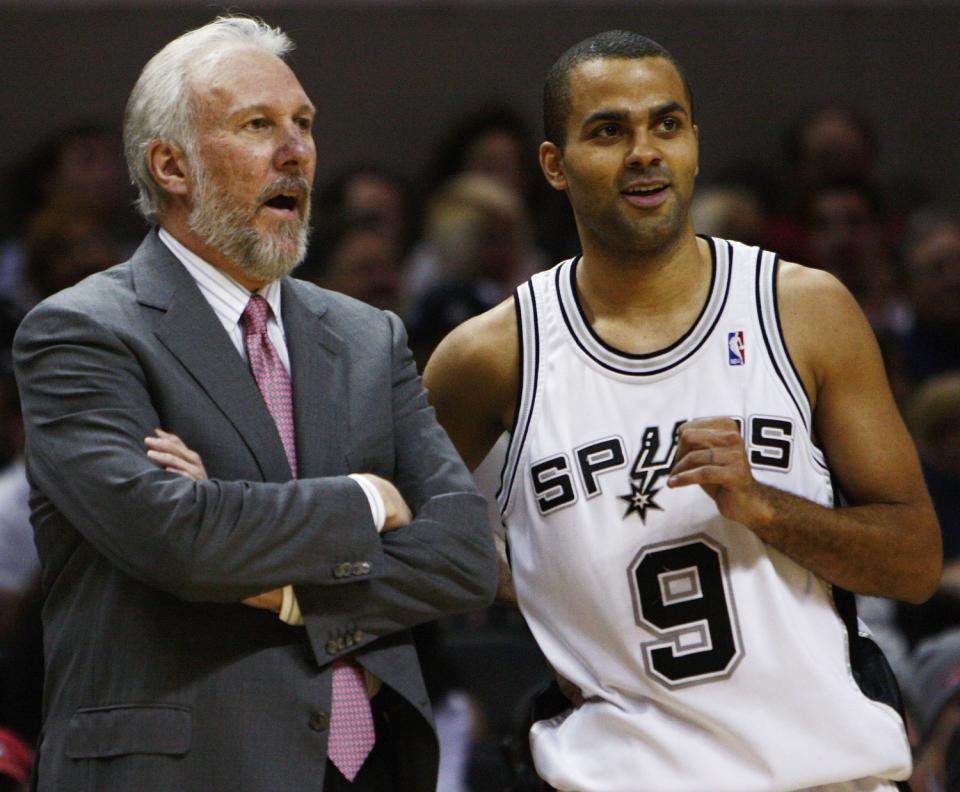
The coach, Hudson Scott, struck most as a pleasant man who, word had it, excelled at coaching volleyball. He’d taken on the hoops team because no one else would. His motivation tactics consisted of saying things like, “Try to keep them under 100 and score 50.”
Caltech stood on the verge of an unfortunate distinction: fall to Pomona and its losing streak would hit 100. Though that ate at Edwards and McMurtry, Zas took it in stride. “I wish I was better at being competitive,” he said. “But given my physical limitations, I didn’t spend hours playing basketball. The way some people talk about winning and losing, I guess it just didn’t bother me in the same way. I’d just focus on setting good screens.” He pauses. “Playing for Caltech was really the equivalent in some ways to heading to the gym for a lunch pickup game.”
That's not how the new Pomona-Pitzer coach approached the game.
Early on, after one bumbling loss or another, Gregg Popovich had turned to his wife, Erin, the woman who’d been so supportive — who’d encouraged his dream of being a coach, who’d followed him to Colorado and now to this tiny, academic school in the boonies of college basketball.
What have I done, he recalls telling her. Where have we come? Why did we do this?
A decade earlier, Popovich had been the leading scorer at the Air Force Academy, good enough to receive an invite to the 1972 U.S. Olympic team tryouts. By 1979, he felt ready for a head coaching job. Pomona wouldn’t have been his first choice, but when Voelkel offered, he and Erin gave it a go. The campus and academic atmosphere appealed to him.
Upon his arrival, Pop received a present from the outgoing coach, Nagler: a photo of the team. On the border of the photo, Nagler had scrawled: “My legacy — The 14 'Blue Chippers' I left you. Good Luck! Coach Nagler.”
Looking back, Popovich recalled one moment in particular. “So it's one of the first games of the season and all of a sudden, there's a timeout,” Popovich said. “And I'm on the ref's ass, 'I didn't call timeout!’ ” The ref points to Pop’s bench. “And he goes, ‘He did.’ And it was one of the guys on my team, his hair down to his shoulders.”
Popovich couldn’t believe it. “And I said to the guy, ‘What'd you do?’ He goes, ‘I called timeout.’ I said, ‘Seriously? That's what I do.’ He goes, ‘No, I always call timeouts.’ I said, ‘Not anymore you don't!’”
As frustrating as coaching could be, Popovich dove into the Pomona culture off the court. Along with Erin and their two young kids, he lived in Harwood Court, a dorm, with the students. He befriended faculty, seeking out the handful of professors at the school whose fire burned as his did, including Voelkel, a young history professor named Lorn Foster, and Koblik. Soon enough, he’d persuaded Koblik to be the “faculty advisor” to the team, in hopes it could sway admissions on borderline candidates. “I made up the position,” Popovich said.
The professors let off steam by playing on an intramural team, Koblik, Foster, and Voelkel joined by Popovich, decimating the students. “Gregg could rebound better than anyone in Claremont, handle the ball better than anyone on the team,” Koblik said. “Remember, he almost made the NBA. He was a made basketball player, not a born one.”
Along the way, Koblik took it upon himself to act as a Pop whisperer. “My primary job was to stop him from killing anybody,” Koblik said.
Popovich might have faced a mass player exodus had he acted off the court as he did on it. But the contrast could be startling. “He’d invite us over to his house, and his wife would make cookies and ask about our academics,” Johnson said. “He really cared. And then back on the practice floor he was brutal.”
Eventually, this goodwill paid off, cementing deep relationships. But at the time, three months into the season, the situation appeared dire. A shorthanded roster, a bunch of kids who’d never really been coached, and a tough conference schedule upcoming.
Still, a pecking order existed and, on it, at least two teams fell below the Sagehens: La Verne and Caltech. The players certainly knew it. Before playing La Verne, Popovich assessed his team and said: “I can’t believe a team that is 1-18 can be overconfident.”
::
Game night: Jan. 30, 1980, 7:30 p.m.
Estimates vary on how many people were in the stands that night. McMurtry, the Caltech wing, guesses 50. Popovich remembered, “My wife, my two little children and not much else.”
As to what unfolded over the next two hours, no video exists of the game, only memories, box scores and the postgame writeup in the California Tech, the student newspaper. We do know that, in the first quarter, the Sagehens came out uncharacteristically hot.
All season, the team had struggled to score. Popovich had even taken to gimmick offenses. In practices, the team spent a lot of time running four-on-four drills, often because of a lack of bodies, and became relatively adept in the formation. So Popovich had tried to use this to his advantage, and, at times, he told Johnson, the team’s best outside shooter, to stand 40 feet from the basket. Then he ran a four-out offense, leaving the post unoccupied. If Johnson’s man drifted off him, he slid in for an open shot.
Pomona jumped out to an early lead, but Caltech countered. The Beavers ran a methodical motion offense, designed to limit mistakes (and the margin of defeat). Lacking anyone who could create off the dribble, they passed and passed and passed, switching sides and screening and feeding the post. It could prove infuriating to opposing teams.
Perhaps it got to Pomona on this night. Because, going into the half, Caltech remained within striking distance, down 33-28. Edwards, the Caltech point guard, recalls feeling vaguely hopeful. Then again, he’d stayed up the better part of the previous two nights studying for a test, so it could have just been fatigue.
For the Sagehens, halftime proved memorable. Pop wasn’t pleased.
“I remember a lot of yelling coming from their locker room,” Edwards said. “We had to walk by it to get to ours. He was pissed.”
Edwards and his Caltech teammates thought little of the man doing it — most didn’t even know the Pomona coach’s name. They were just excited that they’d made some other coach mad.
The emotion appears to have carried over. Under the heading of “NON-PLAYER DATA”, the scorebook for Pomona-Pitzer reads “Technical – Coach.”
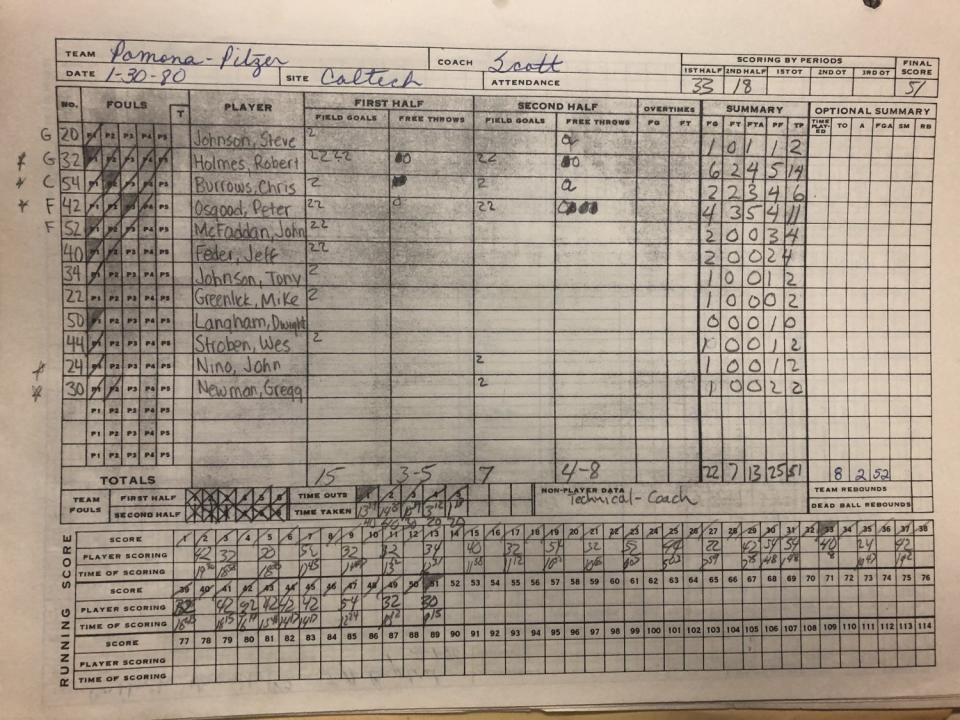
No one recalls how Popovich got it, including him, but his players are inclined to give him the benefit of the doubt. “He got them when he felt like we were finally playing as hard as he wanted us to play and things didn’t go our way,” Johnson said. “He reserved the right to be critical of us and protective of anyone else being critical of us, and he felt that way about the officials.”
Johnson paused. “He had a very colorful vocabulary, shall we say.”
Perhaps the technical helped. In the second half, Pomona began to pull away. With nine minutes remaining, according to the Tech newspaper, the Sagehens led 51-41. For Caltech, that counted as a near-insurmountable gap. The streak, it seemed, would live to see another day.
And then, something changed. Caltech got a stop. Then another. Meanwhile, the offense came alive — a “blitz” the student paper would term it though, judging by the statistics, it appears the blitz occurred primarily at the free-throw line. Regardless, each trip offered an opportunity. And, to the surprise of all, the Beavers knocked them down, 19 of 25 in the second half.
The gap closed.
The Caltech players couldn’t recall the last time a game had been this close, this late. “Most of the time, you just knew eventually you were going to crumble,” Edwards said. “But we felt like we could play with these guys.”
The momentum continued. A deficit turned into a lead.
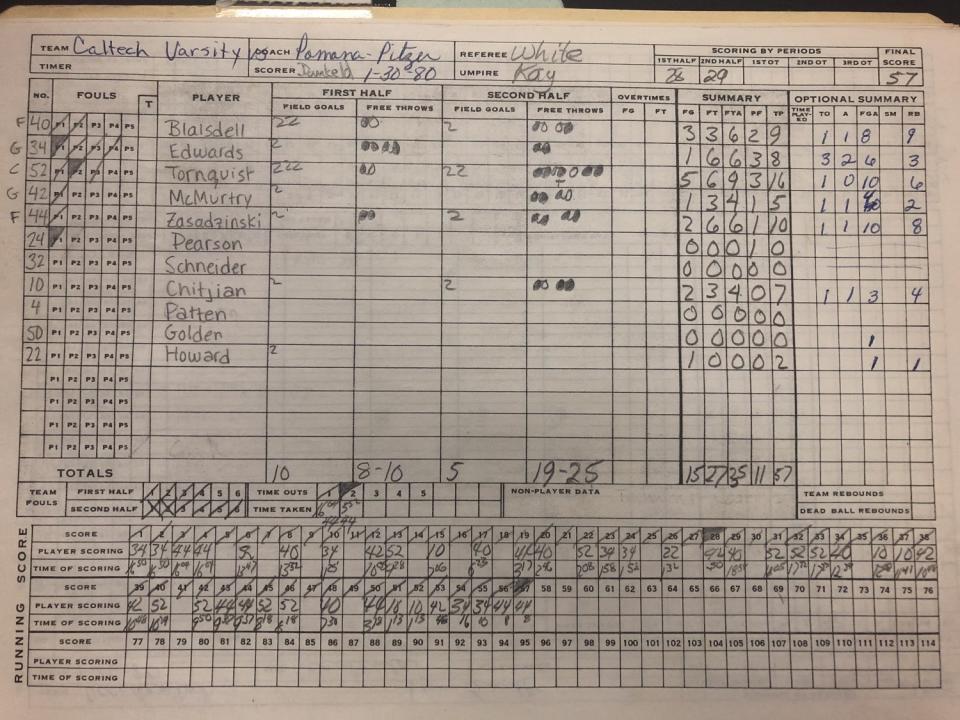
The minutes ticked down. Finally, a few Caltech players began to believe. McMurtry, perhaps the most competitive player on the team, began to freak out a bit. “One thing I remember distinctly,” he said, “is we made a basket with about two minutes left and they called [a] timeout and I think we’re up by five. And our whole team is celebrating and I'm horrified, shouting, ‘You guys, we haven’t won the game yet.'”
But then Edwards, the senior, nailed two more free throws and, not long after, Zas calmly nailed two of two. On the Pomona-Pitzer sideline, Popovich had what he would term “a chilling realization”: I was going to be the coach that ended the streak.
::
The buzzer sounded.
Edwards recalls falling on all fours. McMurtry engulfed Zas, who later would feel bad that he and his teammates had celebrated so raucously, but, as he points out, it wasn't like they'd had any practice.
They had reason to rejoice. Somehow Caltech's defense had held Pomona-Pitzer scoreless over the final nine minutes. And now they were off the hook.
The Caltech seniors would graduate having won a conference game. The program had its first win in a decade.
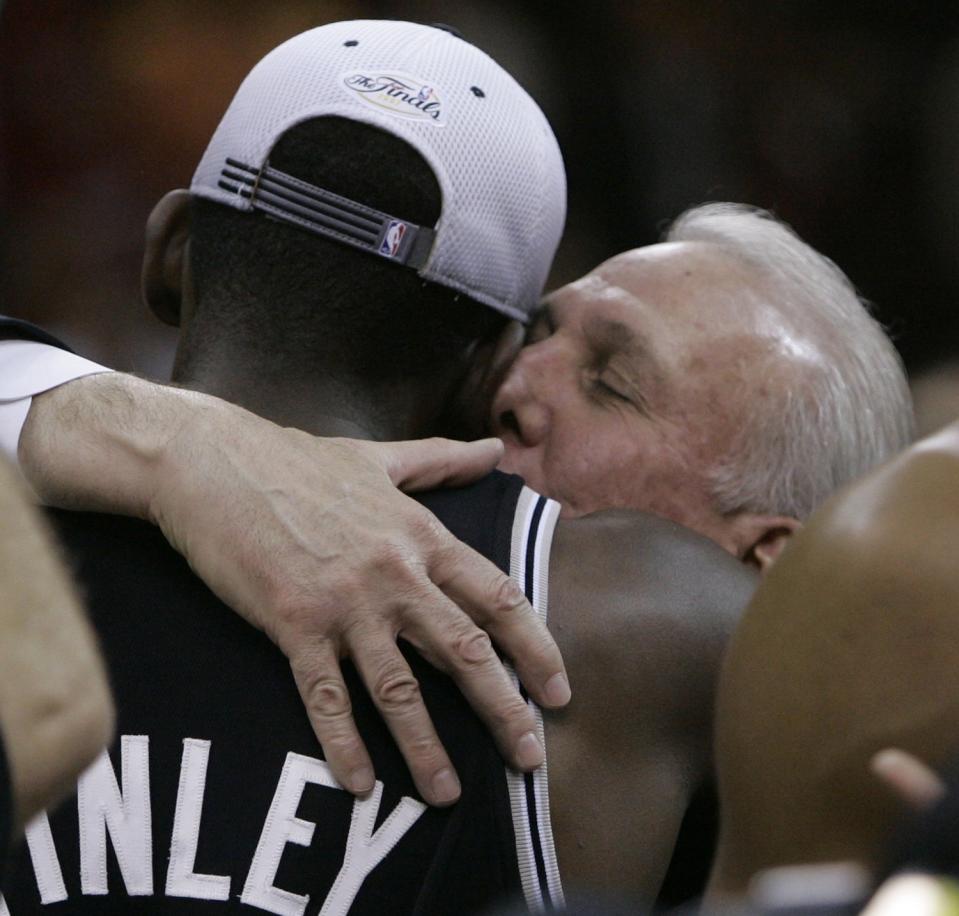
Little did they know how rare the moment would be; the Beavers would win but one more conference game in the next 31 years.
As for Pomona, the loss stung. Even to the end, the Sagehens hadn’t expected this. “I didn’t think they could actually beat us,” Osgood said. Now they went down as The Team That Lost to Caltech.
That night, the players headed back, despondent. Meanwhile, Popovich hit what amounted to coaching rock bottom, leading to another late-night conversation with Erin. This is what he came to California for? This is the life he chose for them? To lose to a collection of players who saw the game as a break from their studies?
Not that he viewed Caltech in a negative light. Popovich says he respected “the hell out of that team.” For the players’ intelligence and academic drive. For what they were up against.
While his players faded from the public view, Popovich did not.
The reclamation of Pomona-Pitzer was about to begin. It began with letters. Division III coaches didn’t usually recruit. But, as Pop figured it, after finishing 2-22 in his first year — the Sagehens beat Caltech in the rematch — it was his only chance at success. So he wrote to every school and every coach he could find. I need smart kids who can play basketball, he told them.
The next season, Popovich made all the players try out again. Only Johnson and Osgood made the team (both would stick all four years). Slowly at first, then more quickly, the program improved. The Sagehens began to beat teams they hadn’t beaten in a long time. They won 10 games the next season, finished .500 the one after. They knocked off Occidental on the road, which hadn’t happened in forever. Afterward, Popovich got the players in the van and drove them to Tommy’s, a burger joint. Then, as Johnson recalls, Popovich made for the Occidental campus and took a couple of loops, honking the horn. Johnson said: “He was enjoying himself.”
As you might expect, Popovich was hard on players. “Gregg went through point guards the way most of us go through toilet paper,” Foster said. “The kids who were willing to work stayed.” He also became a mentor and friend. Made them what he called “Serbian tacos.” Talked to them about politics and culture. Became, as Koblik said, “Maybe the most popular faculty member on campus.”
Then, in 1986, Pomona broke its own drought, winning its first outright SCIAC title in 68 seasons. The team’s best player, Dave DiCesaris, who set scoring records, had passed up Division I offers to play for Pomona-Pitzer.
Two years later, Popovich joined Larry Brown’s staff in San Antonio as an assistant coach, ended up the head coach eight years later, and, well, you probably know what happened from there.
Meanwhile, Caltech took a minute to bask in its win.
Netmen Get a Miracle, read the headline in the next issue of the California Tech. “Dreams do come true,” the story began. “It just takes longer at Caltech.”

That spring, Zas and Edwards graduated. Zas headed off to pursue his doctorate. Edwards became, to the best of his knowledge, the first Black man to get a bachelor's in chemical engineering at Caltech. Two years later, he began his own doctorate program.
In the years that followed, the players drifted apart. Most forgot about that season and that game. Then, in 2006, a documentary film maker named Rick Greenwald called some of them. Said he was making a film about Caltech called "Quantum Hoops." Turns out the school had started a new streak, one that dwarfed the 99 games. It now numbered more than 200.
Zas and McMurtry sat for interviews. And it was only then, when Greenwald brought it up, that they realized who had coached Pomona on that night. Zas said: “My initial response: You’re f—ing kidding me!” He couldn’t believe it: They had been there for what had to be the worst loss of Gregg Popovich’s career.
Not long after, Caltech hired a new coach, a former MIT assistant named Oliver Eslinger. Like Popovich, he recruited. He began a newsletter. He believed he could not only win one game but make the Beavers competitive in the SCIAC. He kept a diary, full of scribbled plays and ideas. Networked with coaches across the country. And, in 2011, watched as his team broke a 310-game conference losing streak.
Not long after, a case of pinot noir arrived, with a note of congratulations in neat cursive.
It read: "As a former loser to Caltech, I wish you more wins. Gregg Popovich."
::
Now it is 2021. The players are nearing retirement age. Life has slowed down. They have more time to look back, with the benefit of hindsight.
McMurtry calls that win: “The greatest athletic joy of my life. It made all four years worth it.”
Zas remains tickled by the experience. And Edwards, who still plays pickup hoops, loves to tell teammates he’s “1-0 against Popovich.” (Though, he admits, the reality is that he’s actually 1-1).
As for Popovich, he is amazed people still want to talk about it. “I can’t believe anyone still cares about that f—ing game,” he said with a laugh during a phone interview before a recent Spurs game.
And yet, he talked about it again, for the one thing the famously ornery coach will almost always talk about is Pomona. He remains tied to the program. He kept in touch with players, sent them notes, invited them to dinners on the road. When Chris Burrows, the big-hearted grinder on that first team, died too young, Popovich kept in touch with his widow; he says she and her kids vacation at his place. Foster and Koblik come to the Clippers or Lakers game and reminisce afterward. When Johnson did some high school coaching, Popovich invited him to Spurs training camp. When the Sagehens made a tournament run two years ago, Popovich said he planned to fly out if they made the round of 16.
Indeed, for years, through all the NBA titles and wins, coaching players like Tim Duncan and Manu Ginobili, Pop kept only one game ball his office. It’s from the 1986 SCIAC conference title.
Chris Ballard is an author, freelance journalist and contributing writer at Sports Illustrated
This story originally appeared in Los Angeles Times.

